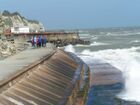Earth:Tetrapod (structure)
A tetrapod is a form of wave-dissipating concrete block used to prevent erosion caused by weather and longshore drift, primarily to enforce coastal structures such as seawalls and breakwaters. Tetrapods are made of concrete, and use a tetrahedral shape to dissipate the force of incoming waves by allowing water to flow around rather than against them, and to reduce displacement by interlocking.[1][2]
Invention
Tetrapods were originally developed in 1950 by Pierre Danel and Paul Anglès d'Auriac of Laboratoire Dauphinois d'Hydraulique (now Artelia) in Grenoble, France , who received a patent for the design.[3] The French invention was named tétrapode, derived from Greek tetra- 'four' and -pode 'foot', a reference to the tetrahedral shape. Tetrapods were first used at the thermal power station in Roches Noires in Casablanca, Morocco, to protect the sea water intake.[4][5]
Adoption
Tetrapods have become popular across the world, particularly in Japan ; it is estimated that nearly 50 percent of Japan's 35,000 kilometers (22,000 mi) coastline has been covered or somehow altered by tetrapods and other forms of concrete. Their proliferation on the island of Okinawa, a popular vacation destination in Japan, has made it difficult for tourists to find unaltered beaches and shoreline, especially in the southern half of the island.[6]
Similar designs
See also
- Earth:Breakwater (structure) – Coastal defense structure
- Earth:Coastal management – Preventing flooding and erosion of shorelines
- Earth:Coastal erosion – Displacement of land along the coastline
- Engineering:Riprap – Rock or concrete protective armour
- Earth:Seawall – Form of coastal defence
References
- ↑ "What are Tetrapods? (Tetrapods Resist Wave Impact and Prevent Beach Erosion)". http://www.brighthubengineering.com/geotechnical-engineering/42962-what-are-tetrapods/.
- ↑ Park, Sang Kil (2014). "Effects of vertical wall and tetrapod weights on wave overtopping in rubble mound breakwaters under irregular wave conditions". https://www.degruyter.com/downloadpdf/j/ijnaoe.2014.6.issue-4/ijnaoe-2013-0224/ijnaoe-2013-0224.pdf.
- ↑ Pierre Danel and Paul Anglès d'Auriac (1963) Improvements in or relating to artificial blocks for building structures exposed to the action of moving water [1]
- ↑ Danel, Pierre (1953). "TETRAPODS" (in en). Coastal Engineering Proceedings 1 (4): 28. doi:10.9753/icce.v4.28. ISSN 2156-1028. https://journals.tdl.org/icce/index.php/icce/article/view/1812.
- ↑ Danel, Pierre (1967). "The Tetrapod". https://icce-ojs-tamu.tdl.org/icce/index.php/icce/article/viewFile/2276/1967.
- ↑ Hesse, Stephen (2007-07-22). "TETRAPODS" (in en-US). The Japan Times Online. ISSN 0447-5763. http://www.japantimes.co.jp/life/2007/07/22/to-be-sorted/tetrapods/.
Further reading
- Lagasse, P.F. (2007). Countermeasures to protect bridge piers from scour. Washington, D.C.: Transportation Research Board. ISBN 978-0-309-09909-7. https://books.google.com/books?id=p_rwqGK9igEC&q=tetrapod+concrete.
- Hesse, Stephen. "The Japan Times environment columnist". Don't You Just Love 'Em ... Tetrapods. The Japan Times. http://search.japantimes.co.jp/cgi-bin/fl20070722x1.html.
- Zimmerman, Claus, ed (2005). Environmentally friendly coastal protection : proceedings of the NATO Advanced Research Workshop on Environmentally Friendly Coastal Protection Structures, Varna, Bulgaria, 25-27 May 2004 (Online-Ausg. ed.). Dordrecht: Springer. ISBN 978-1-4020-3299-8. https://books.google.com/books?id=djHjPj4hmcoC&q=tetrapod+concrete.
- Wijers-HasegawaHesse, Yumi. "Tetrapodistas: Beauty beheld in huge concrete forms". The Japan Times. http://search.japantimes.co.jp/cgi-bin/fl20070722x2.html.
- Hesse, Stephen. "Loving and Loathing Japan's Concrete Coasts, Where Tetrapods Reign". The Asia-Pacific Journal: Japan Focus. http://japanfocus.org/-Stephen-Hesse/2481.
 |





